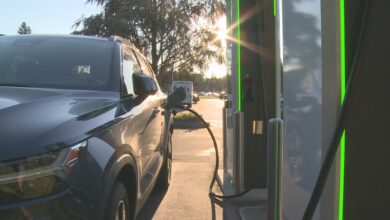Battery breakthrough could usher in greener, cheaper electric vehicles | Newsroom

The global shift to electric vehicles is gaining momentum, yet the extraction of battery materials has a significant environmental footprint that comes with high costs.
Now, two groundbreaking studies led by McGill University researchers offer hope in the search to manufacture cheaper and greener lithium-ion batteries used in electric vehicles (EVs).
Their findings unlock the potential to produce batteries using more sustainable and less costly metals, known as disordered rock-salt-type (DRX) cathode materials.
In the first study, engineering researchers including lead author Richie Fong, a PhD student in Materials Engineering, focused on cathodes. The costliest component of batteries, cathodes are traditionally made from unsustainable metals like cobalt and nickel. Iron could be the cheapest alternative, but until now, existing iron-based cathodes lacked sufficient storage capacity to power a long-range EV.
The findings published in Advanced Energy Materials decisively challenge this perception. The researchers successfully engineered iron-based DRX cathodes by modifying the electron storage process, achieving some of the highest storage capacity ever recorded for iron-based cathode materials. The breakthrough could slash lithium-ion battery costs by 20 per cent.
Richie Fong, a PhD student in Materials Engineering, conducts research on cathodes in a McGill lab.
In a second study, published in Energy & Environmental Science, a team led by Prof. Jinhyuk Lee, an Assistant Professor in the Department of Mining and Materials Engineering and a William Dawson Scholar, unlocked the potential of another sustainable alternative: manganese-based disordered rock-salts (Mn-DRX). This material offers high energy content at a low cost, but its practical application has been hindered by low electrical conductivity and structural instability.
In collaboration with scientists from the Korea Advanced Institute of Science and Technology, they discovered a novel solution. Using multiwalled carbon nanotubes and an adhesive binder as electrode additives, they achieved the highest practical-level energy density ever recorded for Mn-DRX cathodes.
“Our findings hold immense promise for the future of lithium-ion battery development, offering a pathway towards more affordable and sustainable energy storage solutions,” explains Lee, adding that an industry partner is already working alongside the researchers to bring these innovations to market.
About the studies
“Redox Engineering of Fe-Rich Disordered Rock-Salt Li-Ion Cathode Materials” by R. Fong and J. Lee et al. was published in Advanced Energy Materials.
DOI: 10.1002/aenm.202400402
“Nearly all-active-material cathodes free of nickel and cobalt for Li-ion batteries” by E. Lee and J. Lee et al. was published in Energy & Environmental Science.
DOI: 10.1039/d4ee00551a
About McGill University
Founded in 1821, McGill University is home to exceptional students, faculty, and staff from across Canada and around the world. It is consistently ranked as one of the top universities, both nationally and internationally. It is a world-renowned institution of higher learning with research activities spanning three campuses, 12 faculties, 14 professional schools, 300 programs of study and over 39,000 students, including more than 10,400 graduate students.
McGill’s commitment to sustainability reaches back several decades and spans scales from local to global. The sustainability declarations that we have signed affirm our role in helping to shape a future where people and the planet can flourish.



